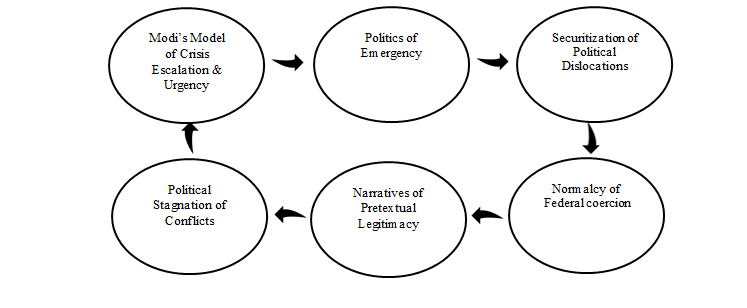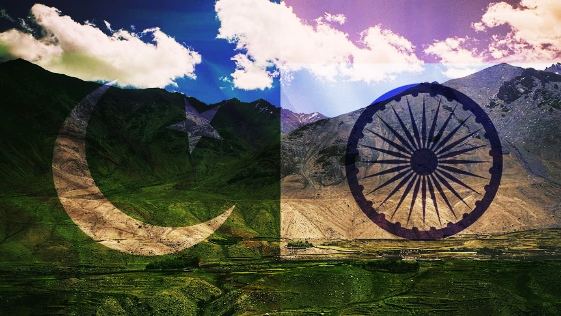As the slashing of Jammu & Kashmir’s asymmetrical status marked its 6th anniversary this year, South Asia recalculates Modi’s politics of normalcy, crisis-handling model, and the political blueprint of its geostrategic conflict zone.
The institutionalization of tourism-led soft power, rule-bound oppression, and territorial rollback strategies in the Green Valley has made it an operationalized epicenter of statist nationalism and coercive statecraft.
The ulterior motives to achieve “discipline by surveillance” in Kashmir through martial suppression have serialized the saffronization of the security hotspot. The emergence of Jammu and Kashmir (J&K) as a diplomatic minefield for strategic dispositions in South Asia has become a political blueprint to exert securitization projects in India, characterized by a series of border frictions with its proximate neighbors.
Is India placing the region at the knife’s edge?
The normalcy paradox with counterinsurgencies and consumerism in Kashmir through paramilitary incursions and jurisdictional coercion converted it into a security-state paradigm. This constructed urgency bolsters the securitization of narratives linked to Kashmir’s entangled sociopolitical knots, creating a political template for crisis normality. These practices of methodical intimidation and provocation compress deliberation protocols in the broader regional security complexes (RSCs) of South Asia, compressing the strategic calculus.
Proximity of forces, paramilitary proliferation, and perennial trust deficits between regional actors are the grim realities of political discord in South Asia. With Kashmir ticking as a regional flashpoint to end civilizational history on a random afternoon, sub-conventional chronicles of a stylized show of strength over the Green Valley subvert strategic humility. Populist projects of Modi to ingrain his domestic overlordship, politics of (in)security to ramp up anti-Pakistan electoral narratives, and instrumental manipulation of ethnocentrism have assembled crisis urgency playbooks in India.
Read More: India’s Diplomatic and Military Predicament Under Modi
From ethnic otherization in Manipur to the manifestation of ethnocracy in West Bengal, the modular tactics of cultural superiority and the arming of primordialism of Hindutva reached the pinnacle of social disjuncture. This societal rupture has also shaped India’s strategically assertive foreign policy in South Asia.
The combination of preventive detentions with preemptive blackouts, followed by the dramatic surge in tourism in J&K, displays a mischaracterized reality of India’s crisis hotspots. The diverse regional variations and political parameters of conflict zones in India have often witnessed security applications over political dialogues. The pushed narrative of normalcy and the propelled construction boom in the Green Valley, through periodic practices of governmentality or film-induced tourism, acts as a mere smokescreen to cloak reputational and retributive costs.
Methodical manipulation of geostrategically crucial hotspots through means of legislative coercion or legitimized illusion of stability is neither an unusual discovery nor an apt method of political deniability. Nonlinear dislocations or transitory inoperativeness of conflict zones have only hardened India’s flexibility in any future crisis; it has made conflict cessation more complex and precarious. The contemporary doctrines of the Bharatiya Janata Party (BJP) and the Trinamool Congress (TMC), disguised in divisive politics, sensationalized narratives, and political conjunctures of bulldozing constitutional powers, have pushed India into a strategic inertia.
With Kashmir’s burning knot gripped by two nuclearized adversaries, India’s internal implosion looms over as it cannot calculate the scale of replication required from the political template of the Green Valley to any political disposition that emerges.
The channel of the chamber of coercion: Rethinking the crises
The erasing of democratic modalities from India’s sociopolitical sphere and the equipping of political reticence by the BJP and the TMC have designed various cartographies of resistance: West Bengal, Jammu & Kashmir (J&K), and Manipur. From the renewed deadly riots in Manipur to the violent uprisings in West Bengal, the BJP has faced two major electoral setbacks as a result of its miscalculated political maneuvers.
The instrumental use of force and performative securitization reflected the state’s regularized mushrooming policies of turning its emergency forces into extrajudicial brigades. The demanded receptivity for communal exceptionalism and internalization of despotism in West Bengal by the BJP-TMC stand-off has culminated in the co-optation of minority pacification and majority constancy in Kolkata.
Read More: Terrorism and the Ballot: How Modi’s BJP Turns Tragedy Into Triumph
As the political monopoly of the BJP in West Bengal continues to face political fractures, the desperate objective of consolidating the populist model of governance has led to tyrannical practices of securitization, political delegitimization, and preemptive legalism in Manipur. With the TMC under Mamata Banerjee continuing to take uncompromising stances against the BJP’s policies, Modi appears to be recalculating the political gridlock and the ungodly tug of war created by the ineffectual domestic face-off between the two parties.
For the TMC, despite periodic attempts by Modi to reactivate his Bismarckian model of crisis urgency and settled instability, the popular support remains intact, even with cycles of legitimacy crisis after the corruption scandals.
The cyclical trajectory of Modi’s crisis-handling model

The endgame of conflict mapping: How long can New Delhi play?
The brutalized leveraging of federal powers, discourse policing for territorial disciplining, has become a regularized practice in India. This playbook of crisis normalcy, under the guise of solidifying state dominion, has legitimized suppressive practices and political aggression; it has prolonged conflicts instead of de-escalating them. The coercive strategies over mediating practices had only radicalized local resistance in Murshidabad, alienated political concerns in Manipur, and turned the bastion of defiance, Jammu and Kashmir (J&K), into a perpetual insurgent hotspot.
The crucible zones of agitation, as witnessed in India’s Manipur and West Bengal, invited concerns from international whistle-blowers, making India’s regional position vulnerable. The internal ethnopolitical complexities of India, with its border and insurgent insecurities from Naypyidaw, and critical observations from Dhaka over West Bengal, all form a trilogy of enigmas.
The rhetorical manipulation of Manipur as a ‘security theatre’ instead of a ‘civic disorder’ that required correction has manifested the BJP’s execution of exemplar-style tactics from Kashmir. As Myanmar remains embattled in a deadly ethnopolitical polity and political insecurities, the looming insecurity of India due to insurgencies, mass exodus of Burmese, and Beijing’s geostrategic presence hints at subverting New Delhi’s sphere of influence. These security theatrics make Manipur the closest model of Kashmir’s replicated security apparatus inside India.
Read More: India Loses Rare Exemption as US Sanctions Chabahar Port Project
The Frequent institutionalization of forceful strategies to achieve political monopolization has resulted in momentary victories for the BJP and TMC. The complacency of both parties to sloganize their political positioning in India by instituting reactionary ideologies has only reinvigorated the use of aggression in political spheres. Perpetual blanket practices to mitigate political ruptures with regions possessing dissimilar sociopolitical realities and civil apprehensions have never been a tactical maneuver for political sustainability.
For India, Kashmir remains a geostrategic exception with contrasting demographic and political situations, but Manipur and West Bengal have extensively witnessed the same tactics of the BJP. The only possible solution that seems strategic and logical is to eliminate the narrative walls of deterrence exercises and arrange rounds of dialogue to coherently stitch the festering wound of the disputed region.
The heated climate of “bullets before ballots” seems to be offering a traditionally accepted narrative of majoritarian populism, and a distressing echo for a Declaration for Democratic Resolve (DDR) to be signed to mellow the political environment. On a transnational level, India needs to strategically engage Myanmar to curtail the fallout of its proliferated ethnopolitical upheavals through diplomatic engagements, border security, and adopting a more post-socialist model of economic collaborations.
Even a hard-border approach with Myanmar would strain India’s ties with the geostrategically crucial ally in the region, and also provide China with an invitation to invest more actively in the state, isolating India’s influence.
*The views expressed in this article are the author’s own and do not necessarily reflect the editorial policy of TDI.
Muhammad Hamza Chaudhary
Muhammad Hamza Chaudhary is a student of International Relations at the University of Punjab, Lahore. His research interests are nuclear security, emerging warfare technologies, and deterrence dynamics of the Middle East and South Asia. He can be reached at hamzachaudhary217@gmail.com



